Dynamic Response Characterization of Floating Structures Based on Numerical Simulations
Abstract
1. Introduction
2. Method for Operational Modal Analysis
2.1. SSI-COV
2.2. Automated Operational Modal Analysis
3. Numerical Models
3.1. NREL 5 MW Semi-Submersible Floating Offshore Wind Turbine
3.2. UMaine-Hywind 5 MW Spar Floating Offshore Wind Turbine
- the modal analysis of the system was carried out by considering the overall mass matrix and the linearized stiffness matrix (taking into account also the mooring system);
- the objective damping matrix was obtained for a reference wave condition, i.e., an Airy wave with height m and period s;
- a set of modal damping ratios was assessed by tuning the theoretical damping matrix of the ideal classically-damped linear system obtained against the objective matrix ;
- the matrix was used as an input in ANSYS® AQWA.
4. Results
4.1. The 5 MW NREL Semi-Submersible Floating Offshore Wind Turbine
- T1-yaw, sway and roll DOF blocked; waves in the surge direction;
- T2-yaw DOF blocked; waves in the surge direction;
- T3-all DOF active; waves in the surge direction;
- T4-yaw DOF blocked; waves at 45º;
- T5-all DOF active; waves at 45º;
- T6-all DOF active; waves at 45º; Cable 1 stiffness reduced to 10% of its original value;
4.2. UMaine-Hywind 5 MW Spar Model
5. Conclusions
- The method proposed is able to identify the modal properties, also in the case of coupled DOFs.
- The method is able to deal with the nonlinearity introduced by the viscous forces in the first case study, as the estimated damping depends on significant wave height.
- If the structure is axisymmetric, the mode shapes are undetermined. This limitation was overcome in the numerical setup by considering a damaged mooring line, i.e., asymmetric stiffness matrix. However, the impact of this shortcoming on real application cases is expected to be reduced, as real structures are not perfectly symmetrical.
- Mode identification changes with wave direction. This variation is consistent with the physics of the platform motion and may be used to detect damaged mooring system conditions.
- The adoption of realistic narrow-banded wave spectra makes the results’ interpretation more challenging; however, acceptable results were obtained for sufficiently long motion time histories.
- Automated tracking of modal properties in the context of continuous dynamic monitoring is possible, and adequate results for natural frequencies and modal damping ratios could be obtained with 30 min time series.
- The estimation of damping coefficients is important to identify modes with similar natural frequencies, as the mode shapes were not always clear.
Author Contributions
Funding
Conflicts of Interest
Abbreviations
| DOF | Degree Of Freedom |
| FAST | Fatigue, Aerodynamics, Structures, and Turbulence |
| FDD | Frequency Domain Decomposition |
| FOWT | Floating Offshore Wind Turbine |
| NREL | National Renewable Energy Laboratory |
| MAC | Modal Assurance Criterion |
| MPP | Multi-Purpose Platform |
| OMA | Operational Modal Analysis |
| SSI-COV | Covariance-driven Stochastic Subspace Identification |
| SWL | Still Water Level |
| TRL | Technology Readiness Level |
| VLFS | Very Large Floating Structures |
| LCOE | Levelized Cost of Energy |
References
- Failla, G.; Arena, F. New perspectives in offshore wind energy. Philos. Trans. R. Soc. A Math. Phys. Eng. Sci. 2015, 373, 20140228. [Google Scholar] [CrossRef]
- Wang, X.; Zeng, X.; Li, J.; Yang, X.; Wang, H. A review on recent advancements of substructures for offshore wind turbines. Energy Convers. Manag. 2018, 158, 103–119. [Google Scholar] [CrossRef]
- Arrambide, I.; Zubia, I.; Madariaga, A. Critical review of offshore wind turbine energy production and site potential assessment. Electr. Power Syst. Res. 2019, 167, 39–47. [Google Scholar] [CrossRef]
- Díaz, H.; Guedes Soares, C. Review of the current status, technology and future trends of offshore wind farms. Ocean Eng. 2020, 209, 107381. [Google Scholar] [CrossRef]
- Brincker, R.; Zhang, L.; Andersen, P. Modal identification from ambient responses using frequency domain decomposition. In Proceedings of the 18th International Modal Analysis Conference (IMAC), San Antonio, TX, USA, 7–10 February 2000. [Google Scholar]
- Roddier, D.; Cermelli, C.; Aubault, A.; Weinstein, A. WindFloat: A floating foundation for offshore wind turbines. J. Renew. Sustain. Energy 2010, 2, 033104. [Google Scholar] [CrossRef]
- Flikkema, M.; Waals, O. Space@Sea the Floating Solution. Front. Mar. Sci. 2019, 6, 553. [Google Scholar] [CrossRef]
- Lagasco, F.; Collu, M.; Mariotti, A.; Safier, E.; Arena, F.; Atack, T.; Brizzi, G.; Tett, P.; Santoro, A.; Bourdier, S.; et al. New Engineering Approach for the Development and Demonstration of a Multi-Purpose Platform for the Blue Growth Economy. In Proceedings of the ASME 2019 38th International Con-ference on Ocean, Offshore and Arctic Engineering, Glasgow, UK, 9–14 June 2019. [Google Scholar] [CrossRef]
- Wang, C.; Tay, Z. Very Large Floating Structures: Applications, Research and Development. Procedia Eng. 2011, 14, 62–72. [Google Scholar] [CrossRef]
- Lamas-Pardo, M.; Iglesias, G.; Carral, L. A review of Very Large Floating Structures (VLFS) for coastal and offshore uses. Ocean Eng. 2015, 109, 677–690. [Google Scholar] [CrossRef]
- Li, L.; Collu, M.; Ruzzo, C.; Failla, G.; Abhinav, K.A.; Arena, F. Analysis of the Coupled Dynamics of an Offshore Floating Multi-Purpose Platform: Part A—Rigid Body Analysis. In Proceedings of the ASME 2019 38th International Con-ference on Ocean, Offshore and Arctic Engineering, Glasgow, UK, 9–14 June 2019. [Google Scholar] [CrossRef]
- Ruzzo, C.; Failla, G.; Arena, F.; Collu, M.; Li, L.; Mariotti, A. Analysis of the Coupled Dynamics of an Offshore Floating Multi-Purpose Platform: Part B—Hydro-Elastic Analysis with Flexible Support Platform. In Proceedings of the ASME 2019 38th International Con-ference on Ocean, Offshore and Arctic Engineering, Glasgow, UK, 9–14 June 2019. [Google Scholar] [CrossRef]
- Stuyfzand, P.J.; Kappelhof, J.W. Floating, high-capacity desalting islands on renewable multi-energy supply. Desalination 2005, 177, 259–266. [Google Scholar] [CrossRef]
- Itiki, R.; Di Santo, S.G.; Itiki, C.; Manjrekar, M.; Chowdhury, B.H. A comprehensive review and proposed architecture for offshore power system. Int. J. Electr. Power Energy Syst. 2019, 111, 79–92. [Google Scholar] [CrossRef]
- Goupee, A.; Koo, B.; Lambrakos, K.; Kimball, R. Model Tests for Three Floating Wind Turbine Concepts. Offshore Technol. Conf. Proc. 2012, 3. [Google Scholar] [CrossRef]
- Shin, H.; Dam, P.T.; Jung, K.J.; Song, J.; Rim, C.; Chung, T. Model test of new floating offshore wind turbine platforms. Int. J. Nav. Archit. Ocean Eng. 2013, 5, 199–209. [Google Scholar] [CrossRef]
- Duan, F.; Hu, Z.; Niedzwecki, J. Model test investigation of a spar floating wind turbine. Mar. Struct. 2016, 49, 76–96. [Google Scholar] [CrossRef]
- Ruzzo, C.; Muggiasca, S.; Malara, G.; Taruffi, F.; Belloli, M.; Collu, M.; Brizzi, L.L.G.; Arena, F. Scaling strategies for multi-purpose floating structures physical modeling: State of art and new perspectives. Appl. Ocean. Res. 2020. Under review. [Google Scholar]
- Ruzzo, C.; Fiamma, V.; Collu, M.; Failla, G.; Nava, V.; Arena, F. On intermediate-scale open-sea experiments on floating offshore structures: Feasibility and application on a spar support for offshore wind turbines. Mar. Struct. 2018, 61. [Google Scholar] [CrossRef]
- Ruzzo, C.; Saha, N.; Arena, F. Wave spectral analysis for design of a spar floating wind turbine in Mediterranean Sea. Ocean Eng. 2019, 184, 255–272. [Google Scholar] [CrossRef]
- Robertson, A.; Jonkman, J. Loads Analysis of Several Offshore Floating Wind Turbine Concepts. In Proceedings of the International Offshore and Polar Engineering Conference, Maui, HI, USA, 19–24 June 2011. [Google Scholar]
- Magalhães, F.; Álvaro, C. Explaining operational modal analysis with data from an arch bridge. Mech. Syst. Signal Process. 2011, 25, 1431–1450. [Google Scholar] [CrossRef]
- Ruzzo, C.; Failla, G.; Collu, M.; Nava, V.; Fiamma, V.; Arena, F. Operational Modal Analysis of a Spar-Type Floating Platform Using Frequency Domain Decomposition Method. Energies 2016, 9, 870. [Google Scholar] [CrossRef]
- Ruzzo, C.; Failla, G.; Collu, M.; Nava, V.; Fiamma, V.; Arena, F. Output-only identification of rigid body motions of floating structures: A case study. Procedia Eng. 2017, 199, 930–935. [Google Scholar] [CrossRef]
- Robertson, A.; Jonkman, J.; Masciola, M.; Song, H.; Goupee, A.; Coulling, A.; Luan, C. Definition of the Semisubmersible Floating System for Phase II of OC4; Technical Report; National Renewable Energy Lab. (NREL): Golden, CO, USA, 2014. [Google Scholar]
- Peeters, B.; De Roeck, G. Reference-based stochastic subspace identification for output-only modal analysis. Mech. Syst. Signal Process. 1999, 13, 855–878. [Google Scholar] [CrossRef]
- Overschee, P.V.; Moor, B.D. Subspace Identification for Linear Systems; Kluwer Academic Publishers: Leuven, Belgium, 1996. [Google Scholar]
- Magalhães, F.; Cunha, A.; Caetano, E. Online automatic identification of the modal parameters of a long span arch bridge. Mech. Syst. Signal Process. 2009, 23, 316–329. [Google Scholar] [CrossRef]
- Pastor, M.; Binda, M.; Harčarik, T. Modal assurance criterion. Procedia Eng. 2012, 48, 543–548. [Google Scholar] [CrossRef]
- Jonkman, J.; Butterfield, S.; Musial, W.; Scott, G. Definition of a 5-MW Reference Wind Turbine for Offshore System Development; Technical Report; National Renewable Energy Lab. (NREL): Golden, CO, USA, 2009. [Google Scholar]
- Ruzzoo, C. A New Approach for Intermediate-Scale Open-Sea Experimental Activities on Offshore Structures: Application to Spar Buoys for Wind Energy Exploitation via a 1:30 Scale Activity. Ph.D. Thesis, Mediterranea University of Reggio Calabria, Reggio Calabria, Italy, 2016. [Google Scholar]
- Jonkman, J. Definition of the Floating System for Phase IV of OC3; Technical Report; National Renewable Energy Lab. (NREL): Golden, CO, USA, 2010. [Google Scholar]
- Siow, C.; Koto, J.; Abyn, H.; Khairuddin, N. Linearized Morison Drag for Improvement Semi-Submersible Heave Response Prediction by Diffraction Potential. J. Ocean. Mech. Aerosp. Sci. Eng. 2014, 6, 8–16. [Google Scholar]
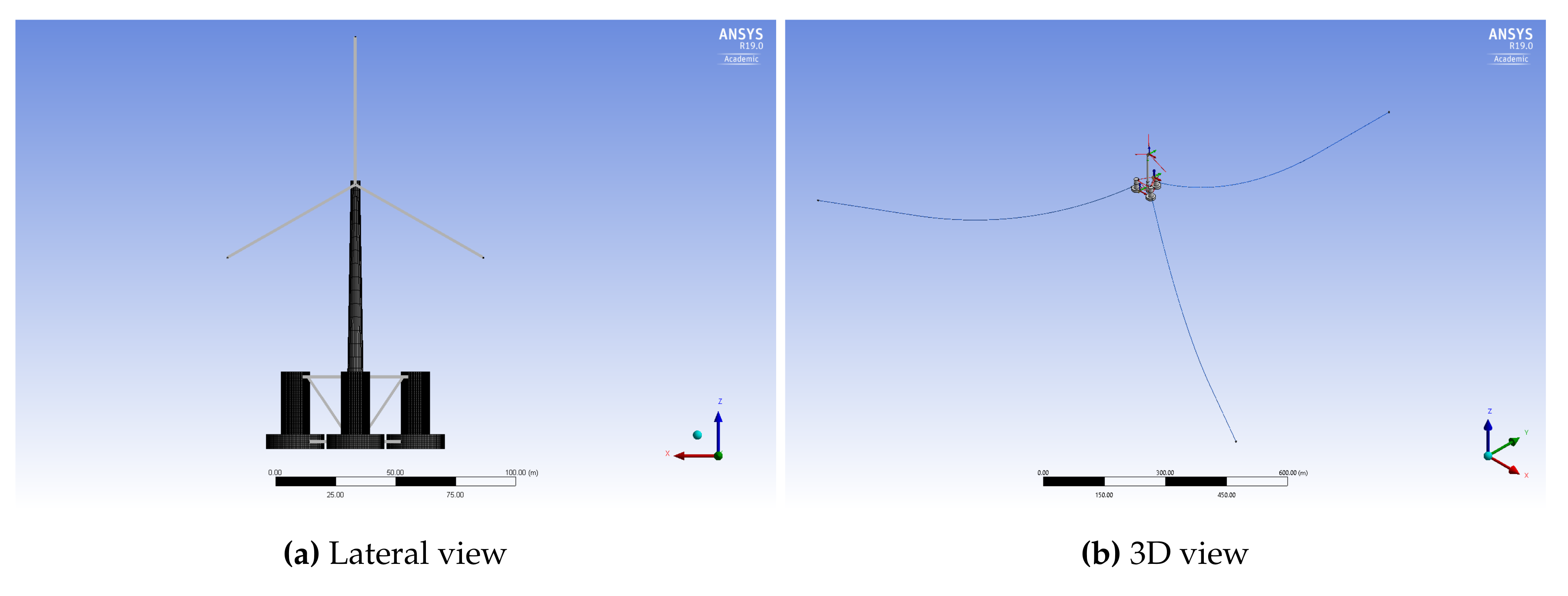
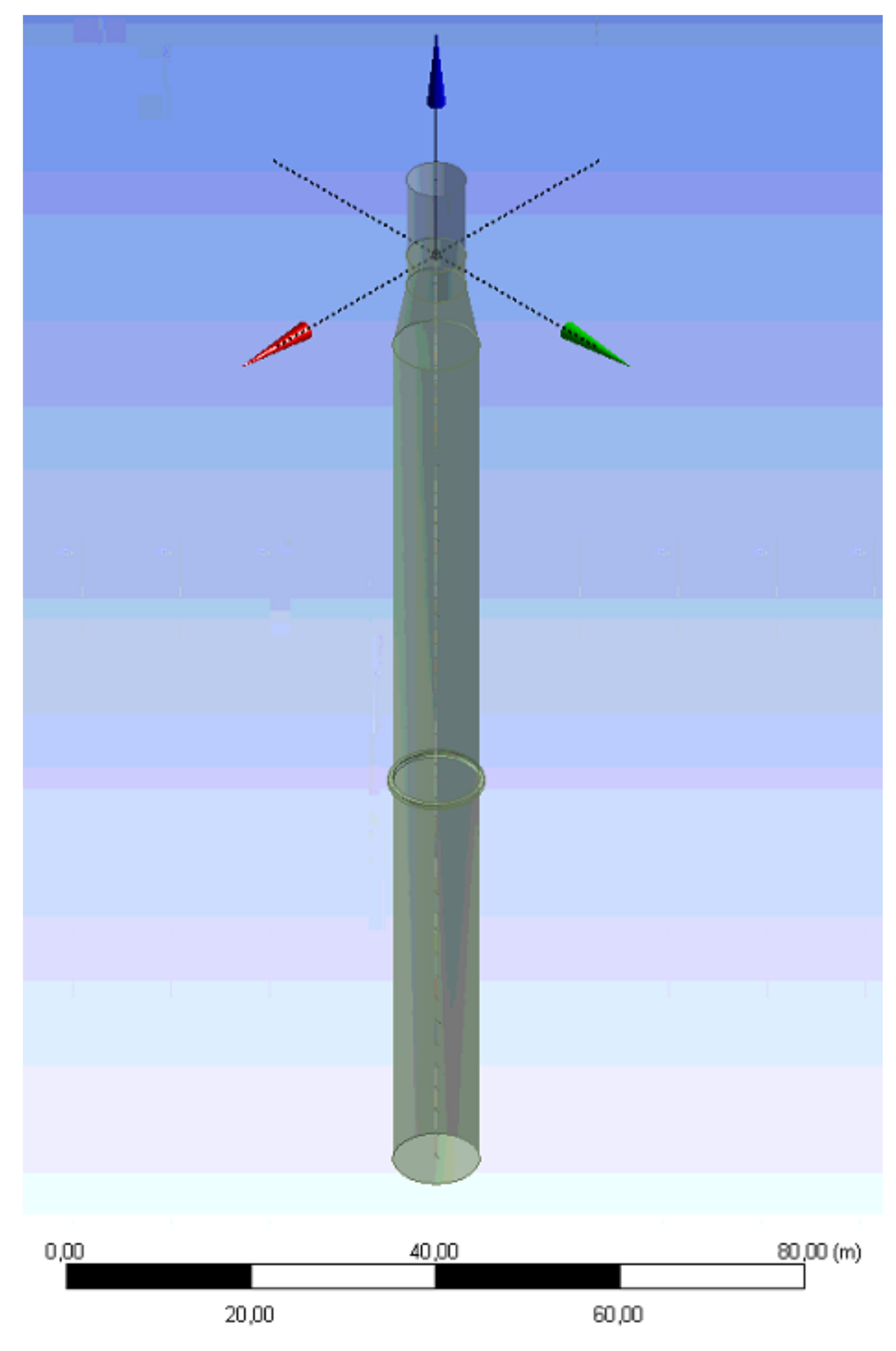
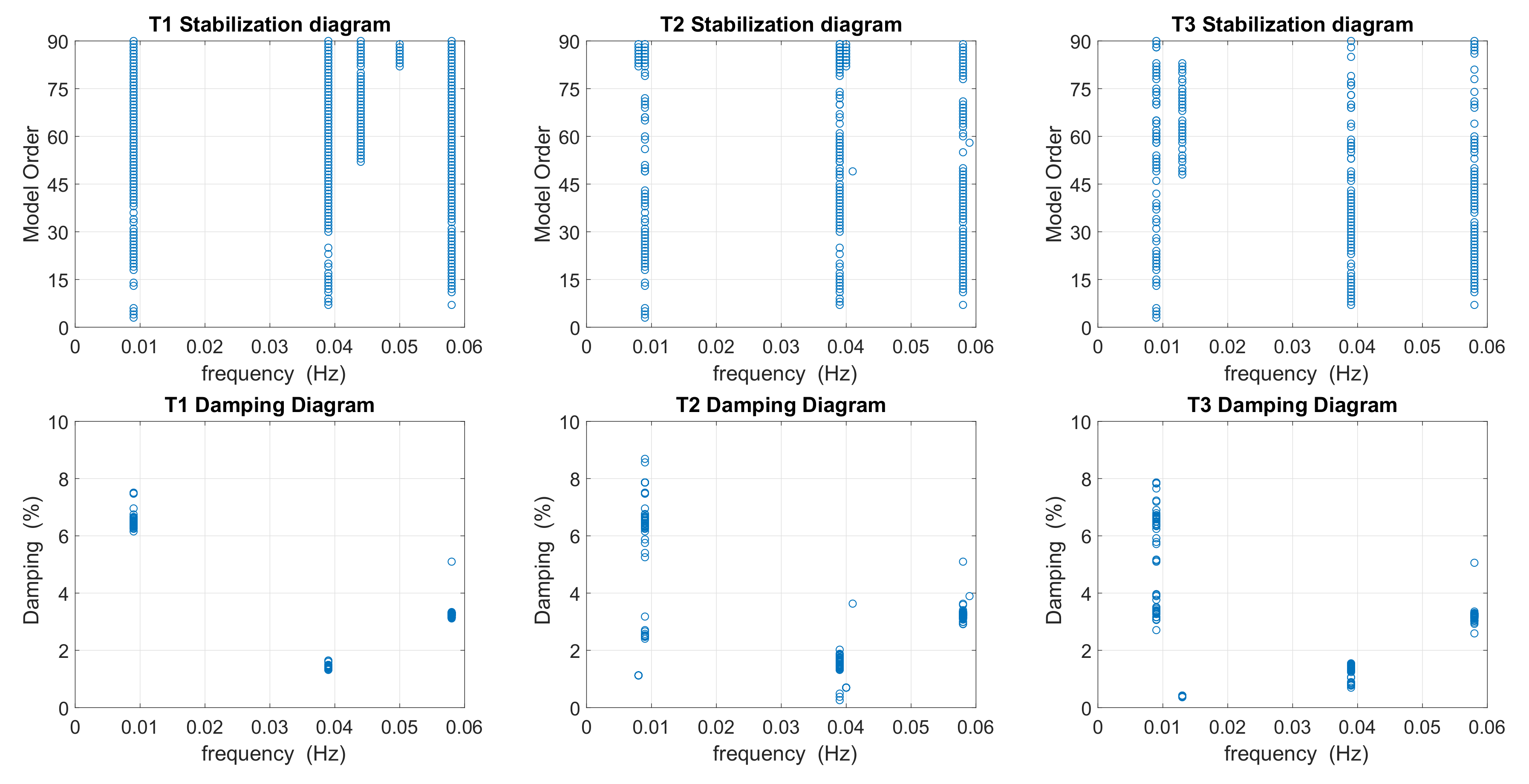
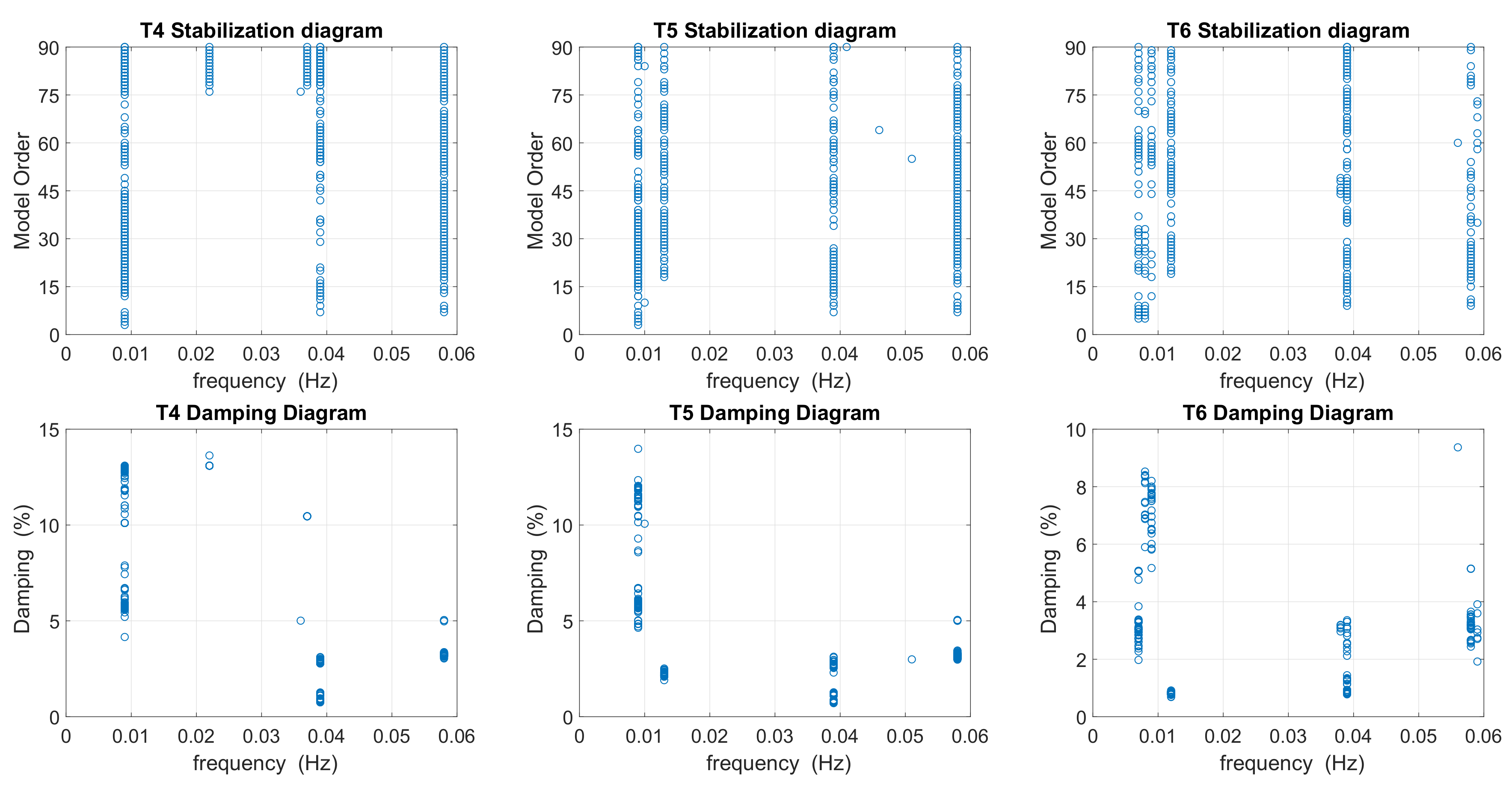
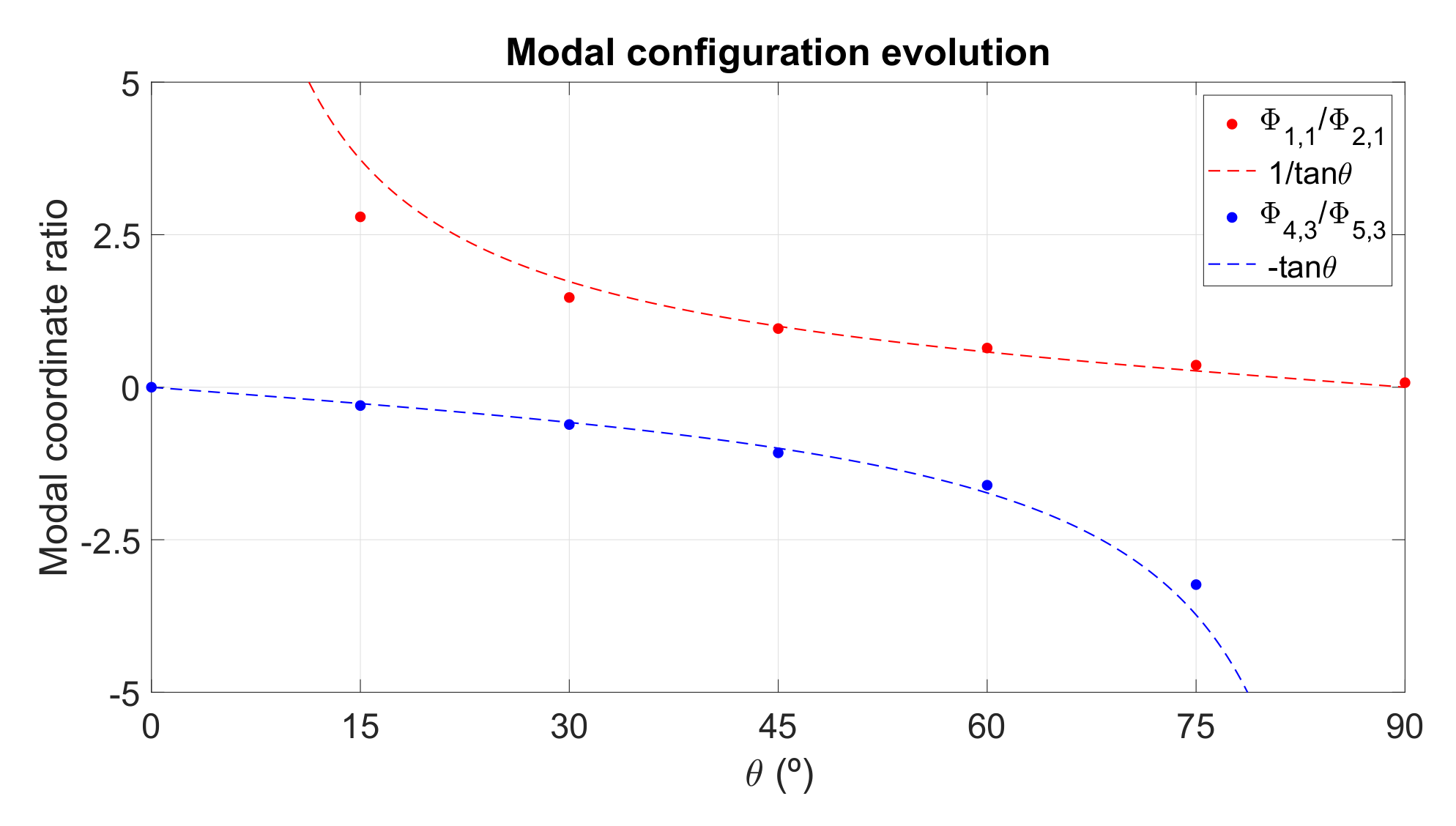

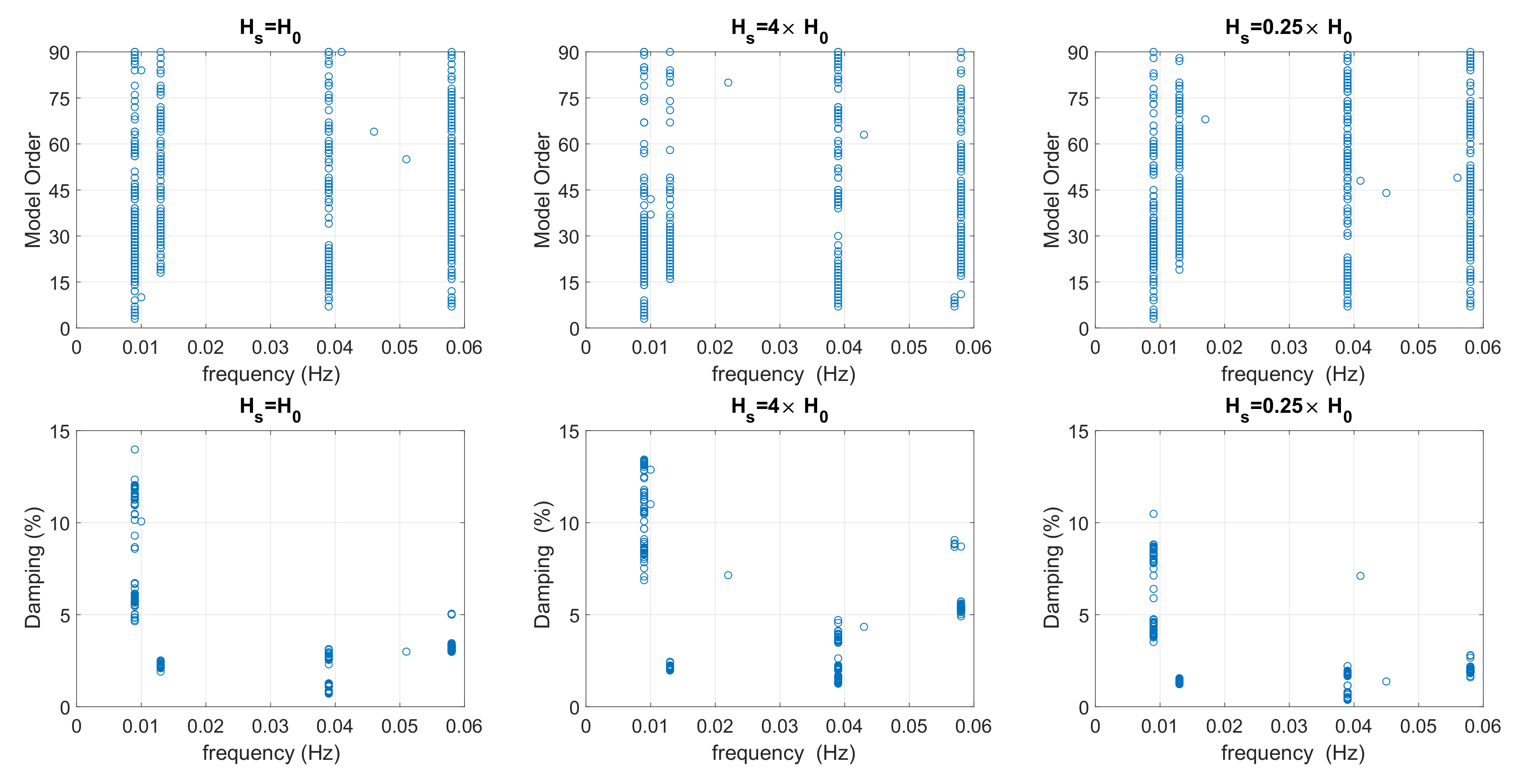
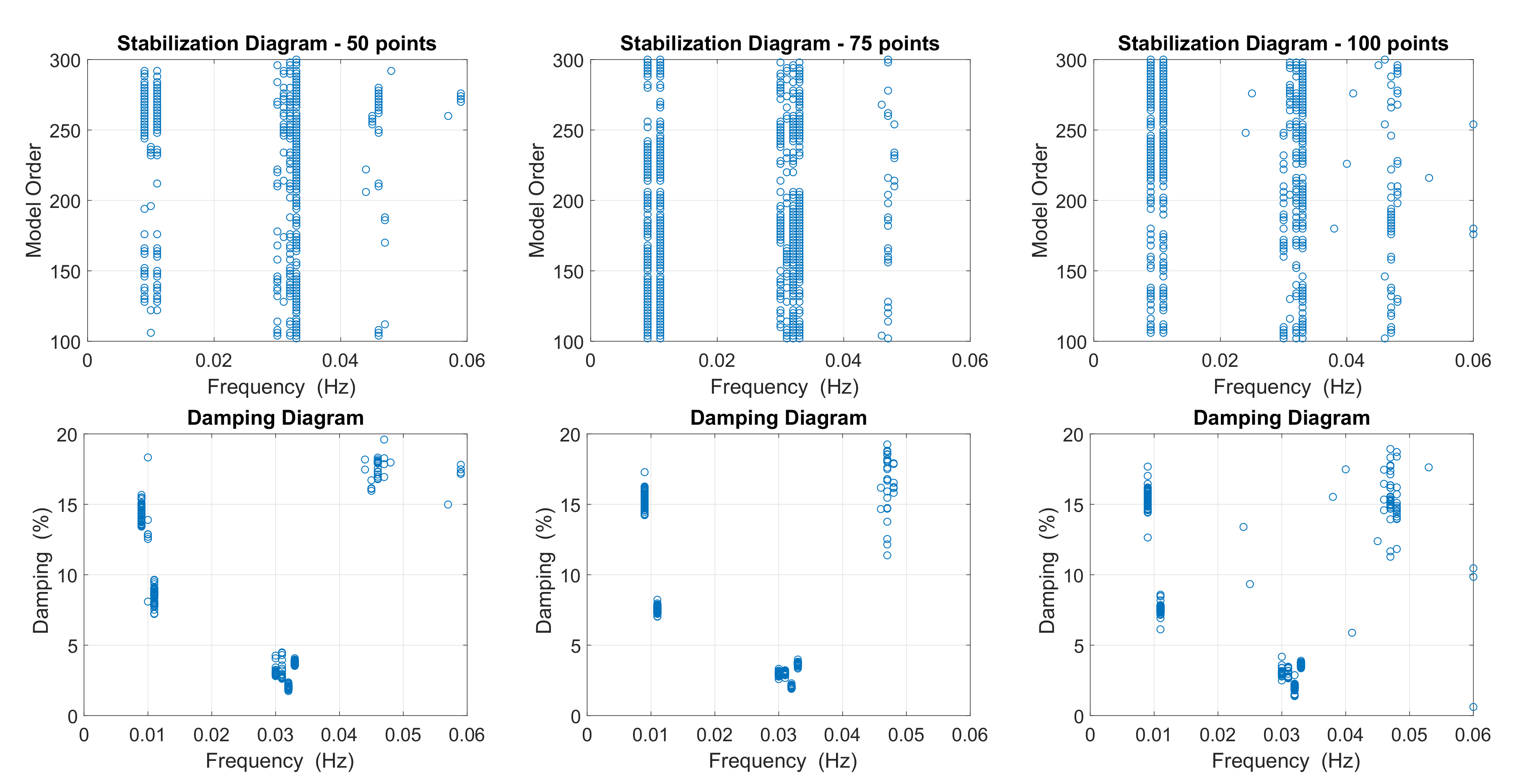
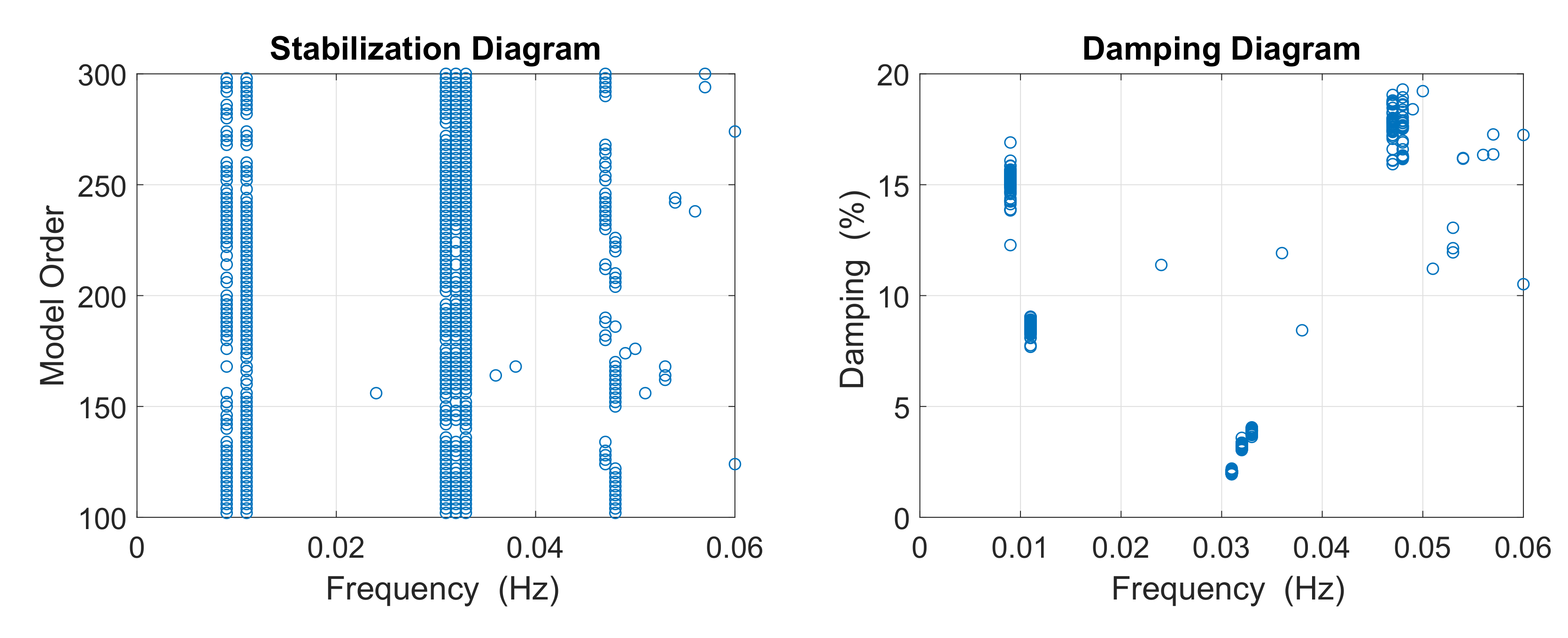
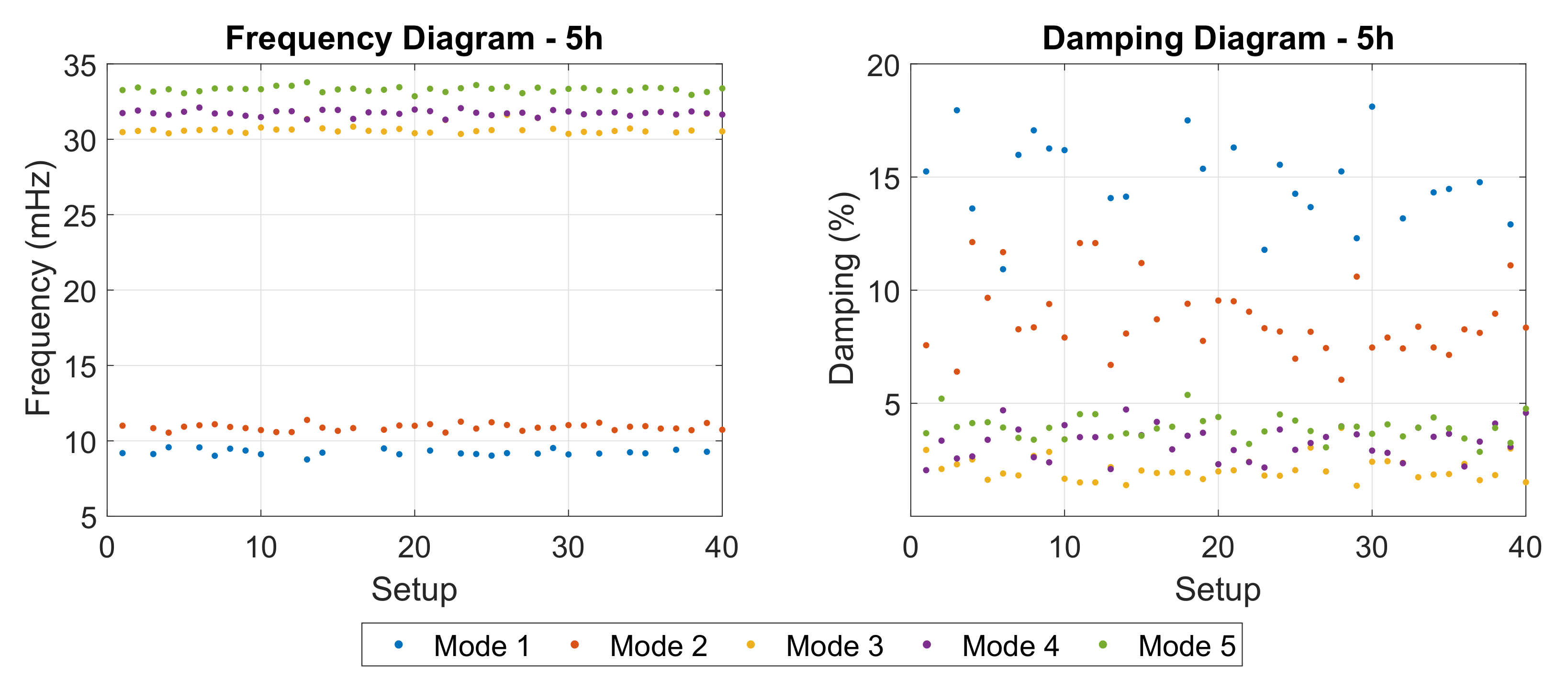
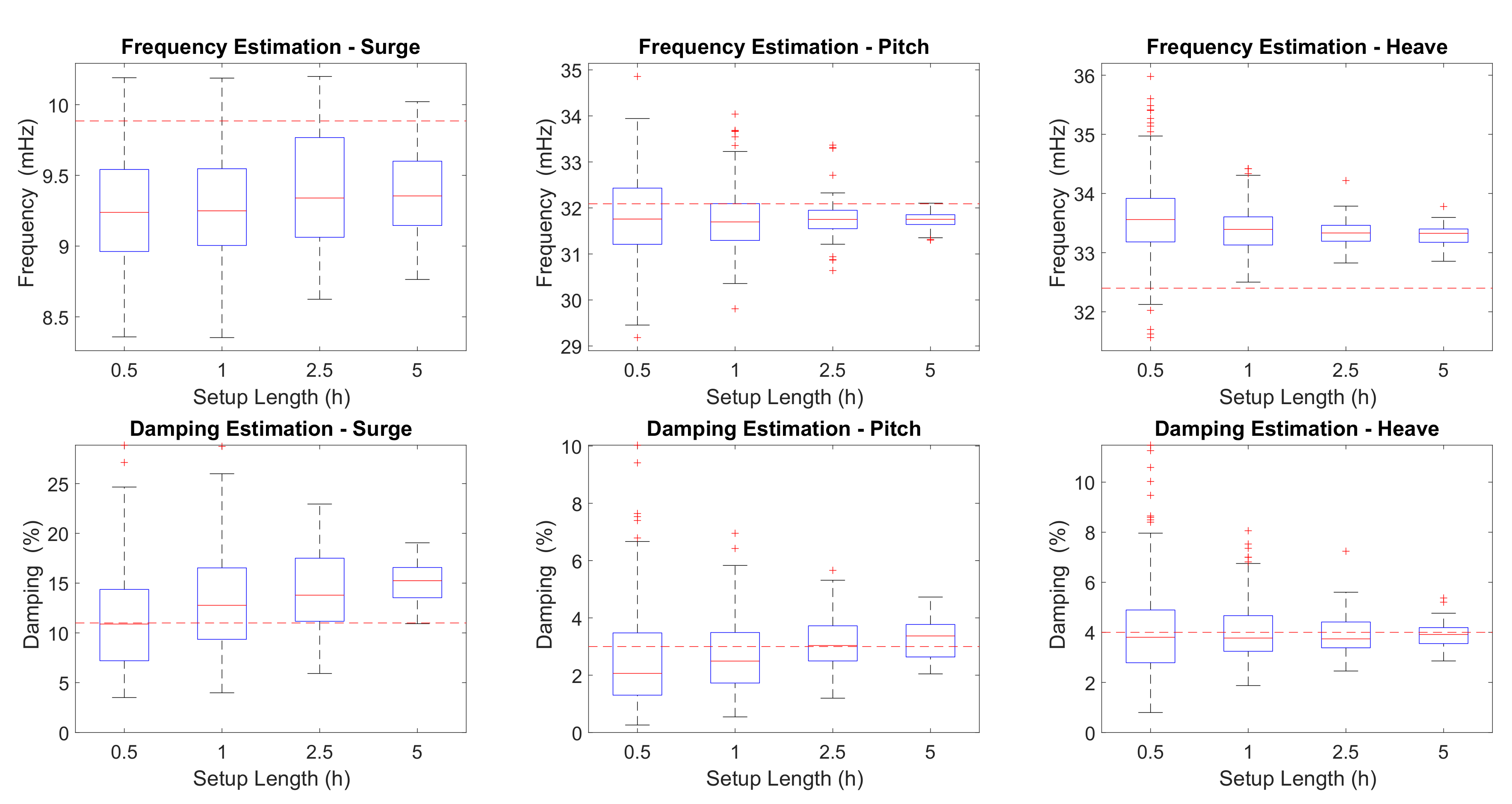
| Parameter | Value | Units |
|---|---|---|
| Overall mass | kg | |
| CoG position | 0 | m |
| CoG position | 0 | m |
| CoG position | −9.85 | m |
| Mass moment of inertia | kg·m | |
| Mass moment of inertia | kg·m | |
| Mass moment of inertia | kg·m |
| Parameter | Value | Units |
|---|---|---|
| Water depth | 200 | m |
| Horizontal distance anchor-fairlead | 796.7 | m |
| Vertical distance anchor-fairlead | 186.0 | m |
| Linear line weight | 113.35 | kg·m |
| Line length | 835.35 | m |
| Equivalent line diameter | 0.0766 | m |
| Transverse drag coefficient of the line | 2 | - |
| Longitudinal drag coefficient of the line | 0.4 | - |
| Added mass coefficient of the line | 0.8 | - |
| Line stiffness | N |
| Parameter | Value | Units |
|---|---|---|
| Diameter | 6.5; 9.4 | m |
| Taper position | −4; −12 | m |
| Overall mass | kg | |
| Center of gravity (CoG) position | 0 | m |
| Center of gravity (CoG) position | −78 | m |
| Mass moment of inertia | kg·m | |
| Mass moment of inertia | kg·m | |
| Mass moment of inertia | kg·m |
| Mode | f | Mode Shapes Components | |||||||
|---|---|---|---|---|---|---|---|---|---|
| (mrad/s) | (mHz) | (%) | X | Y | Z | RX | RY | RZ | |
| 1 | 62.11 | 9.885 | 11 | 1 | 0 | 0 | 0 | 0 | 0 |
| 2 | 71.44 | 11.37 | 8 | 0 | 1 | 0 | 0 | 0 | 0 |
| 3 | 194.8 | 31.00 | 2 | 0.99 | 0 | 0 | 0 | −0.13 | 0 |
| 4 | 201.6 | 32.09 | 3 | 0 | 0.99 | 0 | −0.13 | 0 | 0 |
| 5 | 203.6 | 32.40 | 4 | 0 | 0 | 0 | 1 | 0 | 0 |
| 6 | 912.4 | 145.21 | 6 | 0 | 0 | 0 | 0 | 0 | 1 |
| Parameter | Value | Units |
|---|---|---|
| Water depth | 200 | m |
| Distance anchor-fairlead | 439.8 | m |
| Linear line weight | 145 | kg·m |
| Line length | 468 | m |
| Line stiffness | N |
| Simulation | Mode | f | Mode Shapes Components | |||||||
|---|---|---|---|---|---|---|---|---|---|---|
| (mrad/s) | (mHz) | (%) | X | Y | Z | RX | RY | RZ | ||
| T1 | 1 | 55.3 ± 0.1 | 8.81 ± 0.02 | 6.6 ± 0.2 | 1 | 0 | −0.04 | 0 | 0.04 | 0 |
| 2 | 245.8 ± 0.1 | 39.11 ± 0.02 | 1.47 ± 0.05 | 0.32 | 0 | 0.32 | 0 | 1 | 0 | |
| 3 | 365.6 ± 0.2 | 58.19 ± 0.04 | 3.3 ± 0.2 | −0.57 | 0 | 1 | 0 | −0.08 | 0 | |
| T2 | 1 | 55.4 ± 0.2 | 8.81 ± 0.03 | 6.5 ± 0.7 | 1 | 0 | −0.04 | 0 | 0.04 | 0 |
| 2 | 245.2 ± 0.9 | 39.0 ± 0.2 | 1.5 ± 0.4 | 0.32 | 0 | 0.32 | 0 | 1 | 0 | |
| 3 | 365.6 ± 0.9 | 58.2 ± 0.2 | 3.3 ± 0.3 | −0.56 | 0 | 1 | 0 | −0.08 | 0 | |
| T3 | 1 | 56.1 ± 0.2 | 8.92 ± 0.03 | 6.3 ± 0.8 | 1 | 0 | −0.03 | 0 | 0.04 | 0 |
| 2 | 245 ± 1 | 39.1 ± 0.2 | 1.3 ± 0.3 | 0.31 | 0 | 0.30 | 0 | 1 | 0 | |
| 3 | 365.4 ± 0.5 | 58.2 ± 0.1 | 3.2 ± 0.3 | −0.58 | 0 | 1 | 0 | −0.07 | 0 | |
| T4 | 1 | 55.1 ± 0.3 | 8.77 ± 0.04 | 5.9 ± 0.4 | 0.93 | 1 | −0.04 | 0.03 | −0.04 | 0 |
| 2 | 58.0 ± 0.2 | 9.23 ± 0.04 | 11.7 ± 1.5 | 1 | 0.86 | −0.06 | −0.03 | 0.04 | 0 | |
| 3 | 244 ± 0.4 | 38.9 ± 0.1 | 2.9 ± 0.1 | −0.46 | −0.47 | −0.58 | 1 | −0.94 | 0 | |
| 4 | 246.2 ± 0.3 | 39.2 ± 0.1 | 1.0 ± 0.2 | −0.21 | 0.21 | 0.31 | −0.95 | 1 | 0 | |
| 5 | 365.5 ± 0.4 | 58.17 ± 0.06 | 3.3 ± 0.4 | −0.40 | −0.40 | 1 | 0.03 | −0.04 | 0 | |
| T5 | 1 | 55.6 ± 0.2 | 8.84 ± 0.03 | 5.8 ± 0.5 | 0.96 | 1 | −0.04 | −0.04 | 0.04 | 0 |
| 2 | 58.9 ± 0.3 | 9.37 ± 0.04 | 11.2 ± 0.4 | 1 | 0.76 | −0.07 | −0.03 | 0.04 | 0.01 | |
| 3 | 79.95 ± 0.09 | 12.73 ± 0.02 | 2.2 ± 0.1 | 0.73 | 0.77 | −0.05 | −0.03 | 0.03 | 1 | |
| 4 | 244.5 ± 0.6 | 38.92 ± 0.09 | 2.8 ± 0.2 | −0.51 | −0.51 | −0.61 | 1 | −0.93 | −0.01 | |
| 5 | 246.2 ± 0.3 | 39.18 ± 0.05 | 1.0 ± 0.2 | −0.20 | −0.20 | 0.30 | −0.95 | 1 | −0.01 | |
| 6 | 365.4 ± 0.6 | 58.15 ± 0.09 | 3.3 ± 0.4 | −0.40 | −0.40 | 1 | 0.03 | −0.04 | −0.02 | |
| T6 | 1 | 46.5 ± 0.2 | 7.40 ± 0.03 | 3.3 ± 0.8 | 1 | 0.60 | −0.02 | −0.02 | 0.03 | −0.01 |
| 2 | 54.2 ± 0.2 | 8.62 ± 0.03 | 7.0 ± 0.9 | 0.78 | 1 | −0.05 | −0.03 | 0.02 | −0.02 | |
| 3 | 74.59 ± 0.03 | 11.87 ± 0.01 | 0.82 ± 0.05 | −0.07 | −0.21 | −0.04 | 0.01 | −0.01 | 1 | |
| 4 | 244 ± 2 | 38.8 ± 0.2 | 2.9 ± 0.4 | 0.42 | 0.42 | 0.54 | −1 | 1 | 0 | |
| 5 | 245.7 ± 0.6 | 39.1 ± 0.1 | 1.0 ± 0.2 | −0.24 | −0.20 | 0.29 | −0.93 | 1 | −0.01 | |
| 6 | 366.4 ± 0.9 | 58.3 ± 0.2 | 3.3 ± 0.6 | −0.47 | −0.46 | 1 | 0.04 | −0.04 | −0.02 | |
| Mode | (mrad/s) | f (mHz) | (%) | Mode Shapes Components | |||||
|---|---|---|---|---|---|---|---|---|---|
| X | Y | Z | RX | RY | RZ | ||||
| 1 | 58.85 ± 0.18 | 9.367 ± 0.027 | 15.08 ± 0.58 | 1 | 0.93 | 0.20 | 0 | 0 | 0.01 |
| 2 | 68.63 ± 0.21 | 10.922 ± 0.032 | 8.61 ± 0.22 | 0.70 | 1 | 0.16 | 0 | 0 | 0.01 |
| 3 | 192.06 ± 0.09 | 30.567 ± 0.014 | 2.04 ± 0.05 | −0.28 | 0.27 | 1 | −0.02 | 0.04 | 0.01 |
| 4 | 199.32 ± 0.14 | 31.723 ± 0.021 | 3.25 ± 0.08 | −0.12 | −0.19 | 1 | −0.02 | 0.02 | 0.01 |
| 5 | 208.99 ± 0.11 | 33.261 ± 0.018 | 3.90 ± 0.07 | 0.01 | 0.03 | 1 | 0 | 0 | 0.01 |
| Mode | 0.5 h | 1 h | 2.5 h | 5 h | ||||
|---|---|---|---|---|---|---|---|---|
| f (mHz) | (%) | f (mHz) | (%) | f (mHz) | (%) | f (mHz) | (%) | |
| 1 | 9.2 ± 0.4 | 11.4 ± 5.1 | 9.3 ± 0.4 | 13.3 ± 5.2 | 9.4 ± 0.4 | 14.3 ± 4.1 | 9.4 ± 0.3 | 15.1 ± 2.1 |
| 2 | 11.0 ± 0.5 | 7.0 ± 3.7 | 11.0 ± 0.4 | 7.9 ± 3.3 | 10.9 ± 0.3 | 8.8 ± 3.3 | 10.9 ± 0.2 | 8.7 ± 1.6 |
| 3 | 30.8 ± 0.7 | 2.3 ± 1.7 | 30.8 ± 0.6 | 2.3 ± 1.2 | 30.9 ± 0.5 | 2.4 ± 0.9 | 30.7 ± 0.4 | 2.1 ± 0.5 |
| 4 | 31.8 ± 1.0 | 2.7 ± 1.6 | 31.7 ± 0.7 | 2.7 ± 1.2 | 31.8 ± 0.5 | 3.1 ± 0.9 | 31.7 ± 0.2 | 3.3 ± 0.7 |
| 5 | 33.6 ± 0.6 | 4.0 ± 1.7 | 33.4 ± 0.4 | 4.0 ± 1.2 | 33.3 ± 0.2 | 3.9 ± 0.8 | 33.3 ± 0.2 | 3.9 ± 0.5 |
Publisher’s Note: MDPI stays neutral with regard to jurisdictional claims in published maps and institutional affiliations. |
© 2020 by the authors. Licensee MDPI, Basel, Switzerland. This article is an open access article distributed under the terms and conditions of the Creative Commons Attribution (CC BY) license (http://creativecommons.org/licenses/by/4.0/).
Share and Cite
Pimenta, F.; Ruzzo, C.; Failla, G.; Arena, F.; Alves, M.; Magalhães, F. Dynamic Response Characterization of Floating Structures Based on Numerical Simulations. Energies 2020, 13, 5670. https://doi.org/10.3390/en13215670
Pimenta F, Ruzzo C, Failla G, Arena F, Alves M, Magalhães F. Dynamic Response Characterization of Floating Structures Based on Numerical Simulations. Energies. 2020; 13(21):5670. https://doi.org/10.3390/en13215670
Chicago/Turabian StylePimenta, Francisco, Carlo Ruzzo, Giuseppe Failla, Felice Arena, Marco Alves, and Filipe Magalhães. 2020. "Dynamic Response Characterization of Floating Structures Based on Numerical Simulations" Energies 13, no. 21: 5670. https://doi.org/10.3390/en13215670
APA StylePimenta, F., Ruzzo, C., Failla, G., Arena, F., Alves, M., & Magalhães, F. (2020). Dynamic Response Characterization of Floating Structures Based on Numerical Simulations. Energies, 13(21), 5670. https://doi.org/10.3390/en13215670







